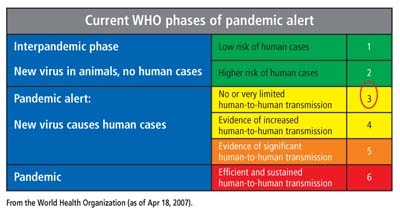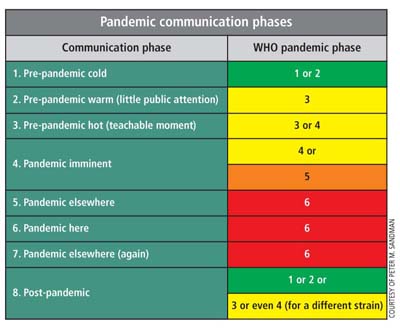As most readers of this newsletter know, the World Health Organization (WHO) says we are currently in phase 3 of six pandemic phases (see chart at right).  We’re no longer in phase 1, because a novel flu virus, H5N1, has appeared on the scene. We’re no longer in phase 2, because H5N1 has successfully passed from a bird to a human (a few hundred times so far). We’ve also seen a few cases of human-to-human transmission, but not enough, in the WHO’s judgment, to justify ratcheting up to phase 4.
We’re no longer in phase 1, because a novel flu virus, H5N1, has appeared on the scene. We’re no longer in phase 2, because H5N1 has successfully passed from a bird to a human (a few hundred times so far). We’ve also seen a few cases of human-to-human transmission, but not enough, in the WHO’s judgment, to justify ratcheting up to phase 4.
As the WHO chart shows, the distinctions among phases 3, 4, 5, and 6 are qualitative, depending on whether human-to-human transmission is “very limited,” “increased,” “significant,” or “efficient and sustained.”
Let me propose a complementary but different set of phases for planning pandemic communications. The WHO pandemic phases are grounded solely in what the virus is doing. The following pandemic communication phases are grounded also in the:
- Intensity of the level of public concern
- Location of the disease
Communication phases

1. Pre-pandemic cold
In the WHO’s phases 1 and 2, pandemic preparedness is off the public’s agenda, and most communication effort would be wasted. There are exceptions – during a severe seasonal flu outbreak, for example, or right after a pandemic. But unless something has happened to arouse the public’s interest and thus create a pandemic teachable moment, the chances of inspiring much pandemic preparedness are next to nil. It still makes sense to lobby for improvements in areas such as public health infrastructure and vaccine technology. But don’t expect to create a communication phase 1 pandemic buzz. Save your ammunition.
2. Pre-pandemic warm
In the WHO’s phase 3, our current phase, the opportunities to communicate improve. At least you can point to H5N1. But people get used to the existence of H5N1 on the horizon, and need something more to recapture their interest – a local outbreak in birds, for example, or a human-to-human cluster anywhere.
In between these teachable moments, it’s not easy to keep the general public (or the media) interested. Reaching out to stakeholders is more feasible. Pandemic communication phase 2 is actually a pretty good time to talk to customers, suppliers, and even employees. You won’t get too strong a reaction – your problem will be apathy, not panic – but you can start building baseline awareness. Try raising pandemic preparedness at safety meetings, for example; think about creating pandemic posters, phone stickers, and the like.
Communication phase 2 is also a good time to cement your progress with people whose awareness has already been aroused during prior teachable moments. For example, get them involved in company preparedness activities, urge them to share their concern with friends and coworkers, and advise them on the next steps in household preparedness.
3. Pre-pandemic hot
Communication phase 3 comes into play whenever the issue catches fire. This phase includes the periodic teachable moments during the WHO’s phase 3 – for example, the first time an H5N1-positive bird is found in North America. It might also include less obvious teachable moments, such as a pandemic-focused movie or TV docudrama. The biggest day so far on the CDC’s pandemic Web site was the day CIDRAP Director Michael Osterholm, editor-in-chief of this newsletter, appeared on The Oprah Winfrey Show.
A teachable moment of special importance occurs any time H5N1 (or any flu strain) looks like it’s getting better at human-to-human transmission. The WHO may take a while to declare phase 4. You don’t have to wait. As soon as word spreads that the WHO is thinking about phase 4, you’ve got a teachable moment. And when the WHO makes the move, you’ve got a gigantic teachable moment.
Capitalizing on teachable moments is crucial to getting your company prepared. While you’re in communication phase 2, spend a lot of effort planning for the next time you get to communication phase 3. (Communication phases 2 and 3 oscillate as teachable moments come and go.)
4. Pandemic imminent
By the time a pandemic looks imminent, the WHO will definitely be in phase 4, maybe even phase 5. Nobody will know the odds of getting this far and not progressing to the WHO’s phase 6. Nobody will know whether the pre-pandemic virus will zoom through 4 and 5 or dawdle in them. And at least for a while, nobody will know whether the pandemic that looks imminent is going to be severe or mild.
Still, communication phase 4 is the mother of all teachable moments. As soon as credible experts start saying a pandemic looks imminent (the defining characteristic of communication phase 4), people you’ve been trying to reach for years will suddenly start paying attention – and complaining that you didn’t warn them earlier. Don’t get defensive; focus instead on urgent preparedness messages.
The tone of your communications should start shifting. You don’t have to arouse people’s concern any more; the situation is doing that for you. Don’t give in to the temptation to overreassure them, either. Now the task is to validate their rising fear, help them bear it, and guide them through it.
5. Pandemic elsewhere
Suppose the WHO declares a pandemic. But it isn’t “here” yet. You may have only a day or two for last-minute preparations; you may have weeks or conceivably even months.
If you’re a multinational company, you’re in communication phase 6 in some of your locations and phase 5 in others. Don’t lose sight of the distinction.
By now you’re starting to get fairly reliable data about how severe the pandemic is shaping up to be. Of course, that can change; flu pandemics can come in waves, and the waves can vary in severity (there’s no clear pattern – later waves can be worse or better than earlier ones). Still, nearly every aspect of your communication phase 5 plan will depend on what you have to say about the severity of the coming pandemic.
You’ll need “subplans” for different severity levels. (One possibility is to use the severity categories defined by the Centers for Disease Control and Prevention.) Phase 5 messages for a mild pandemic will focus on such medical matters as symptoms, vaccines and antivirals, and hospital surge-capacity problems. Phase 5 messages for a severe pandemic will need to address much tougher worries, like shortages of essential goods, disruption of essential services, and threats to the social order. And of course you may have to split the difference if the pandemic’s expected severity is intermediate or still hard to predict.
6. Pandemic here
Everything changes when the pandemic reaches your location – especially if it’s severe. Of course, you will have endless information and instruction to offer your stakeholders, everything from which facilities are open to what supplies are available to how long people should stay home after recovering. But in the middle of a crisis, the most important communication tasks have to do with sustaining people’s ability to bear the unbearable. Validating how awful it is, demonstrating your candor and your determination (not your overoptimism), celebrating heroes, and mourning victims – these are every bit as crucial as anything else you need to tell your employees, customers, and suppliers.
7. Pandemic elsewhere (again)
The pandemic is receding in your area. It’s time to regroup, not relax. Another wave may be coming, and it could be worse than this one was. And of course the pandemic is still raging elsewhere, and supply lines are still wrecked. Regrouping won’t be easy.
As waves come and go, you may need to get through several iterations of communication phases 6 and 7.
8. Post-pandemic
It’s really gone. Now you need a communication effort to help everyone recover. And you have a chance to help everyone segue from debriefing to thinking about long-term preparedness.
Bear in mind that other flu strains circulating could pose a pandemic threat. So maybe we’re back in the WHO’s phase 1 or 2, or maybe we’re in the WHO’s phase 3 (or conceivably even 4) for a different strain. Here is one of my communication worst-case scenarios: In the next year or two, we go through a mild pandemic of some strain other than H5N1. H5N1 still looms, and now we need to convince people to stay worried.
Focus your planning
The purpose of these eight pandemic communication phases is to focus communication planning on communication issues:
- Before a pandemic, what matters most is picking your teachable moments, when you have the best chance to arouse people’s concern and action.
- During a pandemic, the communication phase depends on where the pandemic outbreaks or waves are – and your mid-pandemic messages depend on how severe these outbreaks or waves are.
- After a pandemic, the communication tasks are to help with recovery and to promote continued vigilance and preparedness for the next pandemic.
Copyright © 2007 Regents of the University of Minnesota. Originally published on
the CIDRAP Business Source website, April 19, 2007. Reproduced with permission.

